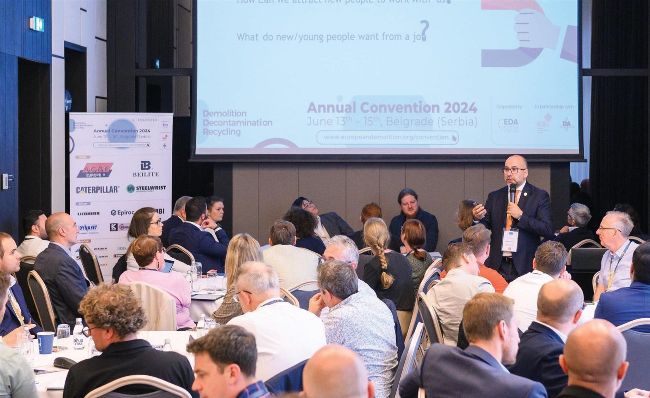A milestone year for EDA
Stefano Panseri, EDA President, reflects on Belgrade and looks ahead to the association's next annual conference
As President of the European Demolition Association, EDA, I am proud to reflect on the success of our Annual Convention 2024, held in the vibrant city of Belgrade, Serbia.
From June 12th to June 15th, over 200 professionals from the demolition, decontamination, and recycling industries gathered for insightful discussions, collaboration, and innovation.
This year’s convention, organised with the Serbian Demolition Association, SDA, offered valuable workshops, presentations, and networking opportunities showcasing our field’s latest advancements and singular projects.
We extend our sincere appreciation to all our sponsors for their invaluable contributions, which played a key role in making this event a success.
A special highlight was the Gala Dinner at Belgrade’s historic White Palace, with folk dance performances that helped to enjoy an unforgettable evening for everyone.
A PERSONAL AND PROFESSIONAL HONOUR
As I look back on the success of this event, it is with a mix of pride and nostalgia.
This year marks my final term as President of the EDA, making the upcoming EDA Study Tour in Italy and the Annual Convention in 2025 especially significant to me.
Not only will it be my last convention as president, but it will also take place in my home country, Italy, a personal and professional honour.

ALL PHOTOS: EDA

The EDA event also comprised workshops in which industry professionals worked together to find solutions for shared challenges.
From June 8th to 12th, the EDA Study Tour 2025 will offer participants a unique opportunity to explore Italy’s demolition industry and the circular economy methodologies that underpin the industry›s future.
For 4 days, an EDA delegation will visit from Milan to Venice several Italian suppliers and contractors.
EDA ANNUAL CONVENTION 2025
Following the tour, from June 12th to 13th, we will hold the EDA Annual Convention 2025 in the stunning city of Venice. This convention, organised in collaboration with the European Decontamination Institute, EDI, and NADECO, Italy’s National Association for Demolition and Circular Economy in Construction, promises to be an extraordinary event that brings together industry professionals from around the world.
The 2025 Convention is particularly meaningful to me, as I will not only serve as one of the hosts for the Study Tour but also close out my time as EDA President, handing over to my colleague, Mr Patrick Frye, on behalf of the French association SEDDRe.
I look forward to sharing this special convention with all of you and continuing our collective work towards shaping a brighter, more sustainable future for the demolition industry. Let’s make the EDA Annual Convention 2025 a fitting finale to our shared journey and a celebration of what comes in the future!
Stefano Panseri,
EDA President
About the EDA
The European Demolition Association (EDA) was founded in 1978 and is the European platform for national demolition associations, demolition contractors and suppliers. It organises annual events to bring together the demolition industry from all over Europe. The most important one is the Annual Convention, a meeting that includes technical presentations about key topics as well as optional leisure activities. The EDA represents thousands of companies through its national associations and direct memberships. Demolition & Recycling International is the international media partner of the EDA.
■ For more details, please visit: www.europeandemolition.org
EDA Convention: Speaker spotlight
While this year’s EDA Annual Convention in Belgrade kicked off with a day of workshops, expert presentations on the second day of the convention provided attendees with a wealth of knowledge.
Key among them was a presentation delivered by expert environmental consultant and bio-geoscientist Marianne Hedberg Miljobygge, who provided insight into the handling and treatment of hazardous substances.
Shining the spotlight on the importance – but often overlooked – impact that insulation has on the earth’s Ozone layer, Marianne referenced the 1989 international Montreal Protocol on Ozone Depleting Substances and its 2016 update, which bans the production and use of chlorofluorocarbons (CFCs) and hydrofluorocarbons (HFCs) and other manmade chemicals (greenhouse gases) used in refrigerants, insulating foams and air-conditioning.
When CFC compounds are released into the atmosphere they make their way up into the earth’s stratosphere, and start to react with the Ozone.
Ozone (O3) is a highly reactive gas made up of three oxygen atoms, that protects the planet from the ultraviolet radiation in space. When CFCs and HFCs mix with the Ozone, they break down the O3 into oxygen (O2), which does not filter out the ultraviolet radiation from space.
“But the CFCs are just a catalyst,” said Marianne. “They take part in the reaction, in the splitting of the O3 into O2, and then go off to the next reaction. And the next reaction, and the next and so on.
“This is why CFCs are so damaging. The compound will eventually break down, but not quickly. If fact, not for 100 years,” she said.
“So whatever was whatever CFCs were produced in the 1970s are still up there, reacting with our Ozone layer”.
HOW DEMOLITION CONTRACTORS SHOULD HANDLE INSULATION
So, what does this mean for demolition, decommissioning and decontamination contractors when dealing with insulation? Marianne explained that “at the time when each piece of insulation was created, it was done by taking the material - polyurethane, for example, and blowing [inflating] it up with a CFC gas.
“And whatever CFC gas was used, still remains in the material’s pores today. Even though it may have been produced in the 1970s or earlier.”
“So, you can see that we have a bit of a problem with this insulation because it is still in many structures around the world. To take care of these materials we need special understanding.”
Marianne added that when any insulation containing material, such as insulated piping, sandwich boards and refrigeration products, are cut, torn or crushed on work sites during the demolition and sorting processes, these CFCs are released into the atmosphere.
She said: “It might be tempting to take metal-covered foam insulation, sandwich boards and other items and send it to a metal scrap dealer, and to get something [money] for it.”
“But then the material is crushed in open air. And what happens to the gas is contained within the insulation and foams? They go up into the stratosphere and destroy the ozone layer.
PREVENTION IS BETTER THAN CURE
To prevent this, Marianne said that demolition contractors must seek out and utilise the services of special recyclers that have the appropriate equipment and permits to safely separate the recyclables from the insulation materials, prior to their incineration.
“This is where the regulations may seem a little bit costly, because the machinery that handles the insulation has to be enclosed in an airtight space.
“Then the pressure of that space has to be reduced to prevent explosions and fire, and after that the material can be crushed.
“Solid, reusable material is then taken out for all recycling - a very high percentage can be recovered. And the hazardous gas can be taken care of by being condensed into a fluid state that can then be sent for destruction.
“It has to be incinerated at 1,200 degrees Celsius or above,” Marianne explained, “Otherwise it will just pass through the process.”
SPECIALIST WASTE MANAGEMENT
“If you send your waste insulation material to just an ordinary recycler or waste management company, the incineration temperature utilised usually only goes up to 850 degrees Celsius, and that is not enough to destroy this hazardous substance.
“So, this is why we need contractors to use proper plants that can handle these materials. These plants must have the appropriate permit to be able to do this.”
Currently, the European Environmental Agency estimates that only 10% of CFC and HFC containing insulation materials are dealt with in the proper manner, suggesting it could be a key growth area for recyclers.